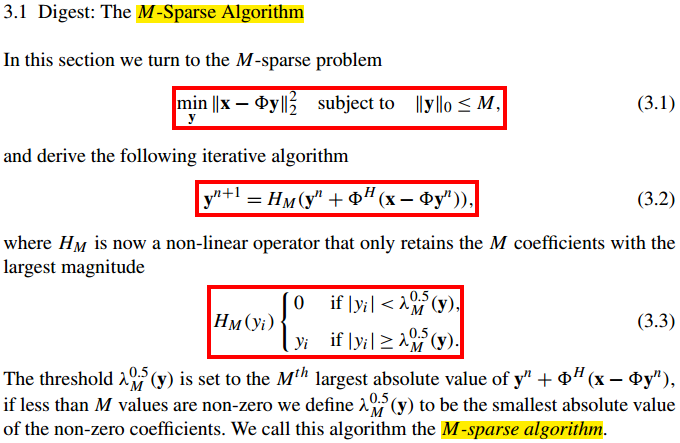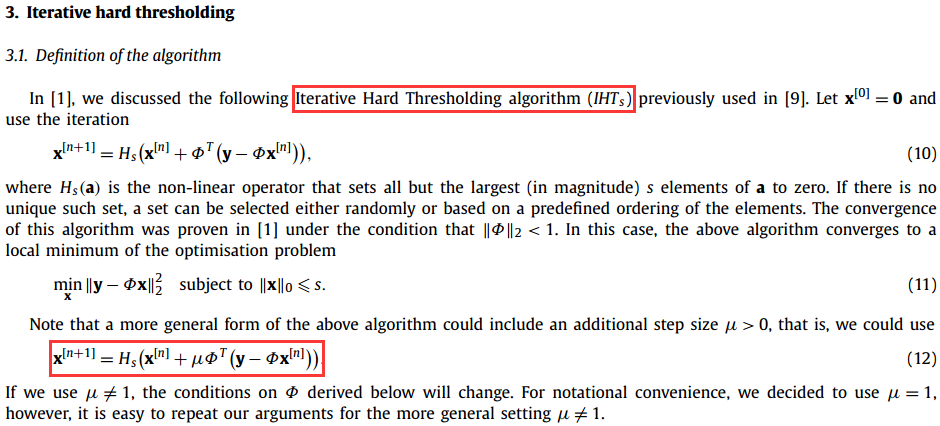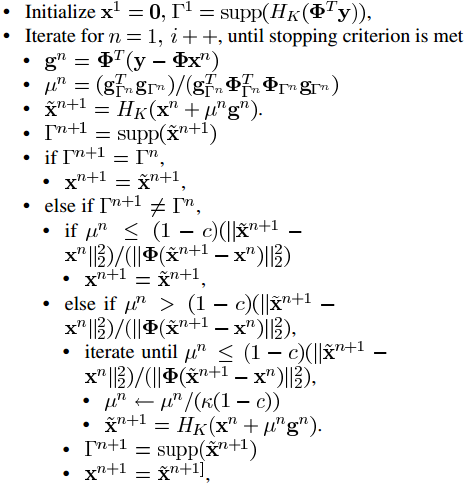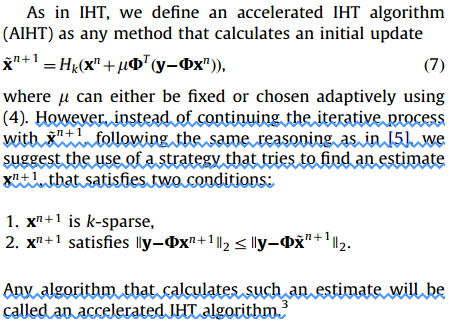题目:压缩感知重构算法之迭代硬阈值(Iterative Hard Thresholding,IHT)
本篇来介绍IHT重构算法。一般在压缩感知参考文献中,提到IHT时一般引用的都是文献【1】,但IHT实际上是在文献【2】中提出的。IHT并不是一种凸优化算法,它类似于OMP,是一种迭代算法,但它是由一个优化问题推导得到的。文献【1】和文献【2】的作者相同,署名单位为英国爱丁堡大学(University ofEdinburgh),第一作者的个人主页见参考文献【3】,从个人主页来看,作者现在已到英国南安普敦大学(University of Southampton),作者发表的论文均可以从其个人主页中下载。
文献【1】的贡献是当把IHT应用于压缩感知重构问题时进行了一个理论分析:
1、迭代硬阈值(IHT)的提出
值得一提的是,IHT在文献【2】中提出时并不叫Iterative Hard Thresholding,而是M-Sparse Algorithm,如下图所示:

该算法是为了求解M-稀疏问题(M-sparse problem)式(3.1)而提出的,经过一番推导得到了迭代公式式(3.2),其中HM(·)的含义参见式(3.3)。
这里面最关键的问题是:式(3.2)这个迭代公式是如何推导得到的呢?
以下Step1~Step4推导过程可以参见本文的补充说明:迭代硬阈值(IHT)的补充说明,若要透彻地理解IHT,需要知道Majorization-Minimization优化框架和硬阈值(Hard Thresholding)函数。
2、Step1:替代目标函数
首先,将式(3.1)的目标函数用替代目标函数(surrogate objective fucntion)式(3.5)替换:

这里中
为什么式目标函数式(3.1)可以用式(3.5) 替代呢?这得往回看一下了……
实际上,文献【2】分别针对两个优化问题进行了讨论,本篇主要是文献中的第二个优化问题,由于两个问题有一定的相似性,所以文中在推导第二个问题时进行了一些简化,下面简单回顾一些必要的有关第一个问题的内容,第一个优化问题是:

将目标函数定义为:

为了推导迭代公式(详见式(2.2)和式(2.3))式(1.5)用如下替代目标函数代替:

这里注意波浪下划线中提到的“[29]”(参见文献【4】),surrogate objective function的思想来自这篇文件。然后注意对Φ的约束(第一个红框),之后以会有这个约束,个人认为是为了使式(2.5)后半部分大于等于零,即为了使

大于等于零(当y=z时这部分等于零)。由此自然就有了式(2.5)与式(1.5)两个目标函数的关系(第二个红框),这也很容易理解,将y=z代入式(2.5)自然可得这个关系。
到此应该明白式(2.5)为什么可以替代式(1.5)了吧……
而我们用式(3.5)替代目标函数

的道理是一模一样的。
补充一点:有关对||Φ||2<1的约束文献【2】中有一处提到了如下描述:
3、Step2:替代目标函数变形
接下来,式(3.5)进行了变形:

这个式子是怎么来的呢?我们对式(3.5)进行一下推导:
这里,后面三项2范数的平方是与y无关的项,因此可视为常量,若对参数y求最优化时这三项并不影响优化结果,可略去,因此就有了变形的结果,符号“∝”表示成正比例。
4、Step3:极值点的获得
接下来文献【2】直接给出了极值点:

注意文中提到了“landweder”,搜索一下可知经常出现的是“landweder迭代”,这个暂且不提。那么极值点是如何推导得到的呢?其实就是一个简单的配方,中学生就会的:
令
当
5、Step4:迭代公式的获得
极值点得到了,替代目标函数的极小值也得到了:

那么如何得到迭代公式式(3.2)呢?这时要注意,推导过程中有一个约束条件一直没管,即式(3.1)中的约束条件:

也就是向量y的稀疏度不大于M。综合起来说,替代函数的最小值是
那么怎么使这个最小值在向量y的稀疏度不大于M的约束下最小呢,显然是保留最大的M项(因为是平方,所以要取绝对值absolute value),剩余的置零(注意这里有个负号,所以要保留最大的M项)。
至此,我们就得到了迭代公式式(3.2)。
6、IHT算法的MATLAB代码
这里一共给出三个版本的IHT实现:
第一个版本:
在作者的主页有官方版IHT算法MATLAB代码,但有些复杂,这里给出一个简化版的IHT代码,方便理解:
function [ y ] = IHT_Basic( x,Phi,M,mu,epsilon,loopmax )
%IHT_Basic Summary of this function goes here
%Version: 1.0 written by jbb0523 @2016-07-30
%Reference:Blumensath T, Davies M E. Iterative Thresholding for Sparse Approximations[J].
%Journal of Fourier Analysis & Applications, 2008, 14(5):629-654.
%(Available at: http://link.springer.com/article/10.1007%2Fs00041-008-9035-z)
% Detailed explanation goes here
if nargin < 6
loopmax = 3000;
end
if nargin < 5
epsilon = 1e-3;
end
if nargin < 4
mu = 1;
end
[x_rows,x_columns] = size(x);
if x_rows<x_columns
x = x';%x should be a column vector
end
n = size(Phi,2);
y = zeros(n,1);%Initialize y=0
loop = 0;
while(norm(x-Phi*y)>epsilon && loop < loopmax)
y = y + Phi'*(x-Phi*y)*mu;%update y
%the following two lines of code realize functionality of H_M(.)
%1st: permute absolute value of y in descending order
[ysorted inds] = sort(abs(y), 'descend');
%2nd: set all but M largest coordinates to zeros
y(inds(M+1:n)) = 0;
loop = loop + 1;
end
end 第二个版本:(作者给出的官方版本)
文件:hard_l0_Mterm.m(\sparsify_0_5\HardLab)
链接:http://www.personal.soton.ac.uk/tb1m08/sparsify/sparsify_0_5.zip
function [s, err_mse, iter_time]=hard_l0_Mterm(x,A,m,M,varargin)
% hard_l0_Mterm: Hard thresholding algorithm that keeps exactly M elements
% in each iteration.
%
% This algorithm has certain performance guarantees as described in [1],
% [2] and [3].
%
%%%%%%%%%%%%%%%%%%%%%%%%%%%%%%%%%%%%%%%%%%%%%%%%%%%%%%%%%%%%%%%%%%%%%%%%%%%
% Usage
%
% [s, err_mse, iter_time]=hard_l0_Mterm(x,P,m,M,'option_name','option_value')
%
%%%%%%%%%%%%%%%%%%%%%%%%%%%%%%%%%%%%%%%%%%%%%%%%%%%%%%%%%%%%%%%%%%%%%%%%%%%
%%%%%%%%%%%%%%%%%%%%%%%%%%%%%%%%%%%%%%%%%%%%%%%%%%%%%%%%%%%%%%%%%%%%%%%%%%%
%
% Input
%
% Mandatory:
% x Observation vector to be decomposed
% P Either:
% 1) An nxm matrix (n must be dimension of x)
% 2) A function handle (type "help function_format"
% for more information)
% Also requires specification of P_trans option.
% 3) An object handle (type "help object_format" for
% more information)
% m length of s
% M non-zero elements to keep in each iteration
%
% Possible additional options:
% (specify as many as you want using 'option_name','option_value' pairs)
% See below for explanation of options:
%__________________________________________________________________________
% option_name | available option_values | default
%--------------------------------------------------------------------------
% stopTol | number (see below) | 1e-16
% P_trans | function_handle (see below) |
% maxIter | positive integer (see below) | n^2
% verbose | true, false | false
% start_val | vector of length m | zeros
% step_size | number | 0 (auto)
%
% stopping criteria used : (OldRMS-NewRMS)/RMS(x) < stopTol
%
% stopTol: Value for stopping criterion.
%
% P_trans: If P is a function handle, then P_trans has to be specified and
% must be a function handle.
%
% maxIter: Maximum number of allowed iterations.
%
% verbose: Logical value to allow algorithm progress to be displayed.
%
% start_val: Allows algorithms to start from partial solution.
%
%
%%%%%%%%%%%%%%%%%%%%%%%%%%%%%%%%%%%%%%%%%%%%%%%%%%%%%%%%%%%%%%%%%%%%%%%%%%%
%
% Outputs
%
% s Solution vector
% err_mse Vector containing mse of approximation error for each
% iteration
% iter_time Vector containing computation times for each iteration
%
%%%%%%%%%%%%%%%%%%%%%%%%%%%%%%%%%%%%%%%%%%%%%%%%%%%%%%%%%%%%%%%%%%%%%%%%%%%
%
% Description
%
% Implements the M-sparse algorithm described in [1], [2] and [3].
% This algorithm takes a gradient step and then thresholds to only retain
% M non-zero elements. It allows the step-size to be calculated
% automatically as described in [3] and is therefore now independent from
% a rescaling of P.
%
%
% References
% [1] T. Blumensath and M.E. Davies, "Iterative Thresholding for Sparse
% Approximations", submitted, 2007
% [2] T. Blumensath and M. Davies; "Iterative Hard Thresholding for
% Compressed Sensing" to appear Applied and Computational Harmonic
% Analysis
% [3] T. Blumensath and M. Davies; "A modified Iterative Hard
% Thresholding algorithm with guaranteed performance and stability"
% in preparation (title may change)
% See Also
% hard_l0_reg
%
% Copyright (c) 2007 Thomas Blumensath
%
% The University of Edinburgh
% Email: thomas.blumensath@ed.ac.uk
% Comments and bug reports welcome
%
% This file is part of sparsity Version 0.4
% Created: April 2007
% Modified January 2009
%
% Part of this toolbox was developed with the support of EPSRC Grant
% D000246/1
%
% Please read COPYRIGHT.m for terms and conditions.
%%%%%%%%%%%%%%%%%%%%%%%%%%%%%%%%%%%%%%%%%%%%%%%%%%%%%%%%%%%%%%%%%%%%%%%%%%%
% Default values and initialisation
%%%%%%%%%%%%%%%%%%%%%%%%%%%%%%%%%%%%%%%%%%%%%%%%%%%%%%%%%%%%%%%%%%%%%%%%%%%
[n1 n2]=size(x);
if n2 == 1
n=n1;
elseif n1 == 1
x=x';
n=n2;
else
error('x must be a vector.');
end
sigsize = x'*x/n;
oldERR = sigsize;
err_mse = [];
iter_time = [];
STOPTOL = 1e-16;
MAXITER = n^2;
verbose = false;
initial_given=0;
s_initial = zeros(m,1);
MU = 0;
if verbose
display('Initialising...')
end
%%%%%%%%%%%%%%%%%%%%%%%%%%%%%%%%%%%%%%%%%%%%%%%%%%%%%%%%%%%%%%%%%%%%%%%%%%%
% Output variables
%%%%%%%%%%%%%%%%%%%%%%%%%%%%%%%%%%%%%%%%%%%%%%%%%%%%%%%%%%%%%%%%%%%%%%%%%%%
switch nargout
case 3
comp_err=true;
comp_time=true;
case 2
comp_err=true;
comp_time=false;
case 1
comp_err=false;
comp_time=false;
case 0
error('Please assign output variable.')
otherwise
error('Too many output arguments specified')
end
%%%%%%%%%%%%%%%%%%%%%%%%%%%%%%%%%%%%%%%%%%%%%%%%%%%%%%%%%%%%%%%%%%%%%%%%%%%
% Look through options
%%%%%%%%%%%%%%%%%%%%%%%%%%%%%%%%%%%%%%%%%%%%%%%%%%%%%%%%%%%%%%%%%%%%%%%%%%%
% Put option into nice format
Options={};
OS=nargin-4;
c=1;
for i=1:OS
if isa(varargin{i},'cell')
CellSize=length(varargin{i});
ThisCell=varargin{i};
for j=1:CellSize
Options{c}=ThisCell{j};
c=c+1;
end
else
Options{c}=varargin{i};
c=c+1;
end
end
OS=length(Options);
if rem(OS,2)
error('Something is wrong with argument name and argument value pairs.')
end
for i=1:2:OS
switch Options{i}
case {'stopTol'}
if isa(Options{i+1},'numeric') ; STOPTOL = Options{i+1};
else error('stopTol must be number. Exiting.'); end
case {'P_trans'}
if isa(Options{i+1},'function_handle'); Pt = Options{i+1};
else error('P_trans must be function _handle. Exiting.'); end
case {'maxIter'}
if isa(Options{i+1},'numeric'); MAXITER = Options{i+1};
else error('maxIter must be a number. Exiting.'); end
case {'verbose'}
if isa(Options{i+1},'logical'); verbose = Options{i+1};
else error('verbose must be a logical. Exiting.'); end
case {'start_val'}
if isa(Options{i+1},'numeric') && length(Options{i+1}) == m ;
s_initial = Options{i+1};
initial_given=1;
else error('start_val must be a vector of length m. Exiting.'); end
case {'step_size'}
if isa(Options{i+1},'numeric') && (Options{i+1}) > 0 ;
MU = Options{i+1};
else error('Stepsize must be between a positive number. Exiting.'); end
otherwise
error('Unrecognised option. Exiting.')
end
end
if nargout >=2
err_mse = zeros(MAXITER,1);
end
if nargout ==3
iter_time = zeros(MAXITER,1);
end
%%%%%%%%%%%%%%%%%%%%%%%%%%%%%%%%%%%%%%%%%%%%%%%%%%%%%%%%%%%%%%%%%%%%%%%%%%%
% Make P and Pt functions
%%%%%%%%%%%%%%%%%%%%%%%%%%%%%%%%%%%%%%%%%%%%%%%%%%%%%%%%%%%%%%%%%%%%%%%%%%%
if isa(A,'float') P =@(z) A*z; Pt =@(z) A'*z;
elseif isobject(A) P =@(z) A*z; Pt =@(z) A'*z;
elseif isa(A,'function_handle')
try
if isa(Pt,'function_handle'); P=A;
else error('If P is a function handle, Pt also needs to be a function handle. Exiting.'); end
catch error('If P is a function handle, Pt needs to be specified. Exiting.'); end
else error('P is of unsupported type. Use matrix, function_handle or object. Exiting.'); end
%%%%%%%%%%%%%%%%%%%%%%%%%%%%%%%%%%%%%%%%%%%%%%%%%%%%%%%%%%%%%%%%%%%%%%%%%%%
% Do we start from zero or not?
%%%%%%%%%%%%%%%%%%%%%%%%%%%%%%%%%%%%%%%%%%%%%%%%%%%%%%%%%%%%%%%%%%%%%%%%%%%
if initial_given ==1;
if length(find(s_initial)) > M
display('Initial vector has more than M non-zero elements. Keeping only M largest.')
end
s = s_initial;
[ssort sortind] = sort(abs(s),'descend');
s(sortind(M+1:end)) = 0;
Ps = P(s);
Residual = x-Ps;
oldERR = Residual'*Residual/n;
else
s_initial = zeros(m,1);
Residual = x;
s = s_initial;
Ps = zeros(n,1);
oldERR = sigsize;
end
%%%%%%%%%%%%%%%%%%%%%%%%%%%%%%%%%%%%%%%%%%%%%%%%%%%%%%%%%%%%%%%%%%%%%%%%%%%
% Random Check to see if dictionary norm is below 1
%%%%%%%%%%%%%%%%%%%%%%%%%%%%%%%%%%%%%%%%%%%%%%%%%%%%%%%%%%%%%%%%%%%%%%%%%%%
x_test=randn(m,1);
x_test=x_test/norm(x_test);
nP=norm(P(x_test));
if abs(MU*nP)>1;
display('WARNING! Algorithm likely to become unstable.')
display('Use smaller step-size or || P ||_2 < 1.')
end
%%%%%%%%%%%%%%%%%%%%%%%%%%%%%%%%%%%%%%%%%%%%%%%%%%%%%%%%%%%%%%%%%%%%%%%%%%%
% Main algorithm
%%%%%%%%%%%%%%%%%%%%%%%%%%%%%%%%%%%%%%%%%%%%%%%%%%%%%%%%%%%%%%%%%%%%%%%%%%%
if verbose
display('Main iterations...')
end
tic
t=0;
done = 0;
iter=1;
while ~done
if MU == 0
%Calculate optimal step size and do line search
olds = s;
oldPs = Ps;
IND = s~=0;
d = Pt(Residual);
% If the current vector is zero, we take the largest elements in d
if sum(IND)==0
[dsort sortdind] = sort(abs(d),'descend');
IND(sortdind(1:M)) = 1;
end
id = (IND.*d);
Pd = P(id);
mu = id'*id/(Pd'*Pd);
s = olds + mu * d;
[ssort sortind] = sort(abs(s),'descend');
s(sortind(M+1:end)) = 0;
Ps = P(s);
% Calculate step-size requirement
omega = (norm(s-olds)/norm(Ps-oldPs))^2;
% As long as the support changes and mu > omega, we decrease mu
while mu > (0.99)*omega && sum(xor(IND,s~=0))~=0 && sum(IND)~=0
% display(['decreasing mu'])
% We use a simple line search, halving mu in each step
mu = mu/2;
s = olds + mu * d;
[ssort sortind] = sort(abs(s),'descend');
s(sortind(M+1:end)) = 0;
Ps = P(s);
% Calculate step-size requirement
omega = (norm(s-olds)/norm(Ps-oldPs))^2;
end
else
% Use fixed step size
s = s + MU * Pt(Residual);
[ssort sortind] = sort(abs(s),'descend');
s(sortind(M+1:end)) = 0;
Ps = P(s);
end
Residual = x-Ps;
ERR=Residual'*Residual/n;
if comp_err
err_mse(iter)=ERR;
end
if comp_time
iter_time(iter)=toc;
end
%%%%%%%%%%%%%%%%%%%%%%%%%%%%%%%%%%%%%%%%%%%%%%%%%%%%%%%%%%%%%%%%%%%%%%%%%%%
% Are we done yet?
%%%%%%%%%%%%%%%%%%%%%%%%%%%%%%%%%%%%%%%%%%%%%%%%%%%%%%%%%%%%%%%%%%%%%%%%%%%
if comp_err && iter >=2
if ((err_mse(iter-1)-err_mse(iter))/sigsize<STOPTOL);
if verbose
display(['Stopping. Approximation error changed less than ' num2str(STOPTOL)])
end
done = 1;
elseif verbose && toc-t>10
display(sprintf('Iteration %i. --- %i mse change',iter ,(err_mse(iter-1)-err_mse(iter))/sigsize))
t=toc;
end
else
if ((oldERR - ERR)/sigsize < STOPTOL) && iter >=2;
if verbose
display(['Stopping. Approximation error changed less than ' num2str(STOPTOL)])
end
done = 1;
elseif verbose && toc-t>10
display(sprintf('Iteration %i. --- %i mse change',iter ,(oldERR - ERR)/sigsize))
t=toc;
end
end
% Also stop if residual gets too small or maxIter reached
if comp_err
if err_mse(iter)<1e-16
display('Stopping. Exact signal representation found!')
done=1;
end
elseif iter>1
if ERR<1e-16
display('Stopping. Exact signal representation found!')
done=1;
end
end
if iter >= MAXITER
display('Stopping. Maximum number of iterations reached!')
done = 1;
end
%%%%%%%%%%%%%%%%%%%%%%%%%%%%%%%%%%%%%%%%%%%%%%%%%%%%%%%%%%%%%%%%%%%%%%%%%%%
% If not done, take another round
%%%%%%%%%%%%%%%%%%%%%%%%%%%%%%%%%%%%%%%%%%%%%%%%%%%%%%%%%%%%%%%%%%%%%%%%%%%
if ~done
iter=iter+1;
oldERR=ERR;
end
end
%%%%%%%%%%%%%%%%%%%%%%%%%%%%%%%%%%%%%%%%%%%%%%%%%%%%%%%%%%%%%%%%%%%%%%%%%%%
% Only return as many elements as iterations
%%%%%%%%%%%%%%%%%%%%%%%%%%%%%%%%%%%%%%%%%%%%%%%%%%%%%%%%%%%%%%%%%%%%%%%%%%%
if nargout >=2
err_mse = err_mse(1:iter);
end
if nargout ==3
iter_time = iter_time(1:iter);
end
if verbose
display('Done')
end第三个版本:
文件:Demo_CS_IHT.m(部分)
链接:http://www.pudn.com/downloads518/sourcecode/math/detail2151378.html
function hat_x=cs_iht(y,T_Mat,m)
% y=T_Mat*x, T_Mat is n-by-m
% y - measurements
% T_Mat - combination of random matrix and sparse representation basis
% m - size of the original signal
% the sparsity is length(y)/4
hat_x_tp=zeros(m,1); % initialization with the size of original
s=floor(length(y)/4); % sparsity
u=0.5; % impact factor
% T_Mat=T_Mat/sqrt(sum(sum(T_Mat.^2))); % normalizae the whole matrix
for times=1:s
x_increase=T_Mat'*(y-T_Mat*hat_x_tp);
hat_x=hat_x_tp+u*x_increase;
[val,pos]=sort((hat_x),'descend'); % why? worse performance with abs()
hat_x(pos(s+1:end))=0; % thresholding, keeping the larges s elements
hat_x_tp=hat_x; % update
end7、单次重构代码
%压缩感知重构算法测试
clear all;close all;clc;
M = 64;%观测值个数
N = 256;%信号x的长度
K = 10;%信号x的稀疏度
Index_K = randperm(N);
x = zeros(N,1);
x(Index_K(1:K)) = 5*randn(K,1);%x为K稀疏的,且位置是随机的
Psi = eye(N);%x本身是稀疏的,定义稀疏矩阵为单位阵x=Psi*theta
Phi = randn(M,N);%测量矩阵为高斯矩阵
Phi = orth(Phi')';
A = Phi * Psi;%传感矩阵
% sigma = 0.005;
% e = sigma*randn(M,1);
% y = Phi * x + e;%得到观测向量y
y = Phi * x;%得到观测向量y
%% 恢复重构信号x
tic
theta = IHT_Basic(y,A,K);
% theta = cs_iht(y,A,size(A,2));
% theta = hard_l0_Mterm(y,A,size(A,2),round(1.5*K),'verbose',true);
x_r = Psi * theta;% x=Psi * theta
toc
%% 绘图
figure;
plot(x_r,'k.-');%绘出x的恢复信号
hold on;
plot(x,'r');%绘出原信号x
hold off;
legend('Recovery','Original')
fprintf('\n恢复残差:');
norm(x_r-x)%恢复残差 这里就不给出重构结果了,给出仿真结论:本人编的IHT基本版能够正常工作,但偶尔会重构失败;第二个版本hard_l0_Mterm.m重构效果很好;第三个版本Demo_CS_IHT.m重构效果很差,估计是作者疑问(why? worse performance with abs()),没有加abs取绝对值的原因吧……
8、结束语
8.1有关算法的名字
值得注意的是,在文献【2】中将式(2.2)称为iterative hard-thresholding algorithm,而将式(3.2)称为M-sparse algorithm,在文献【1】中又将式(3.2)称为Iterative Hard Thresholding algorithm (IHTs),一般简称IHT的较多,多余的s指的是s稀疏。可见算法的名称是也是一不断完善的过程啊……

8.2与GraDeS算法的关系
如果你学习过GraDeS算法(参见http://blog.csdn.net/jbb0523/article/details/52059296),然后再学习本算法,是不是有一种似曾相似的感觉?
没错,这两个算法的迭代公式几乎是一样的,尤其是文献【1】中的式(12)(如上图第二个红框)进一步拓展了该算法的定义。这个就跟CoSaMP与SP两个算法一样,在GraDeS的提出文献【5】中开始部分还提到了IHT,但后面就没提了,不知道作者是怎么看待这个问题的。如果非说二者有区别,那就是GraDeS的参数γ=1+δ2s,且δ2s<1/3。
所以,有想法得赶紧写成论文发表出来,否则被抢了先机那就……
8.3重构效果问题
另外,在GraDeS算法中提到该算法的重构效果不好,这里注意文献【2】中的一段话:

也就是说,IHT作者也意识到了该种算法的问题,并提出了两种应用策略(two strategies for asuccessful application of the methods)。
8.4Landweber迭代
在网上搜索“Landweber迭代”时找到了一段程序[6]:
function [x,k]=Landweber(A,b,x0)
alfa=1/sum(diag(A*A'));
k=1;
L=200;
x=x0;
while k<L
x1=x;
x=x+alfa*A'*(b-A*x);
if norm(b-A*x)/norm(b)<0.005
break;
elseif norm(x1-x)/norm(x)<0.001
break;
end
k=k+1;
end注意该程序的迭代部分“x=x+alfa*A'*(b-A*x);”,除了多了一些alfa系数外,这跟IHT不是基本一样么?或者说与GraDeS有什么区别?
有关LandWeber迭代可参见文献:“Landweber L. An iteration formula for Fredholm integral equations of the first kind[J]. American journal of mathematics, 1951, 73(3): 615-624.”,此处不再多述。
8.5改进算法
作者后来又提出了两个关于IHT的改进算法,分别是RIHT(Normalized IHT)[7]和AIHT(Accelerated IHT)[8]。
提出RIHT主要是由于IHT有一些缺点[7]:

新算法RIHT将会有如下优点:
之所以作者提供的软件包(第二个版本IHT)重构效果更好是由于最新版的hard_l0_Mterm.m (\sparsify_0_5\HardLab)程序中已经更新成了RIHT。

RIHT的算法流程如下:
将IHT改进为AIHT后会有如下优点[8]:

值得注意的是,AIHT应该是一类算法的总称(虽然作者只阐述了两种实现策略),这个类似于FFT是所有DFT快速算法的总称:
8.6稀疏度对IHT的影响
自己可以试一下,IHT输入参数中的稀疏度并不是很关键,若实际稀疏度为K,则稀疏度这个输入参数只要不小于K就可以了,重构效果都挺不错的,比如第三个版本的IHT程序,作者直接将稀疏度定义为信号y长度的四分之一。
8.7作者去向?
细心的人会发现,文献【8】的暑名单位为剑桥大学(University of Oxford),并不是作者主页所在的南安普敦大学(University of Southampton),在文献【8】的最后南提到:

Previous position?难道作者跳到Oxford了?
9、参考文献
【1】Blumensath T, Davies M E.Iterative hard thresholding for compressed sensing[J]. Applied & Computational HarmonicAnalysis, 2008, 27(3):265-274. (Available at:http://www.sciencedirect.com/science/article/pii/S1063520309000384)
【2】Blumensath T, Davies M E.Iterative Thresholding for Sparse Approximations[J]. Journal of Fourier Analysis & Applications,2008, 14(5):629-654. (Available at:http://link.springer.com/article/10.1007%2Fs00041-008-9035-z)
【3】Homepageof Blumensath T :http://www.personal.soton.ac.uk/tb1m08/index.html
【4】Lange, K., Hunter, D.R., Yang, I.. OptimizationTransfer Using Surrogate Objective Functions[J]. Journal of Computational &Graphical Statistics, 2000, 9(1):1-20. (Available at: http://sites.stat.psu.edu/~dhunter/papers/ot.pdf)
【5】GargR, Khandekar R. Gradient descent with sparsification: an iterative algorithmfor sparse recovery with restricted isometry property[C]//Proceedings of the26th Annual InternationalConference on Machine Learning. ACM, 2009: 337-344
【6】shasying2. landweber迭代方法.http://download.csdn.net/detail/shasying2/5092828
【7】Blumensath T, Davies M E.Normalized Iterative Hard Thresholding: Guaranteed Stability and Performance[J]. IEEE Journal of Selected Topics in Signal Processing, 2010,4(2):298-309.
【8】Blumensath T. Accelerated iterative hard thresholding[J]. Signal Processing, 2012, 92(3):752-756.































 576
576











 被折叠的 条评论
为什么被折叠?
被折叠的 条评论
为什么被折叠?








